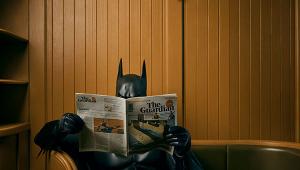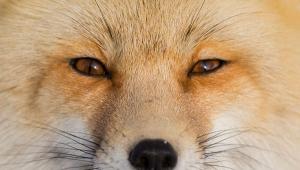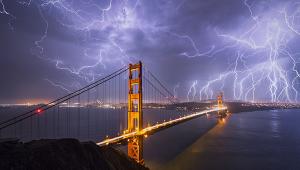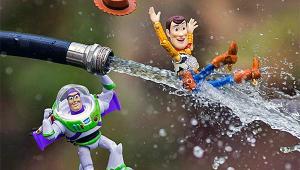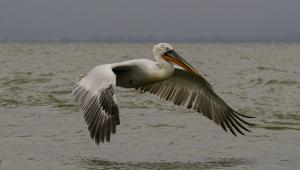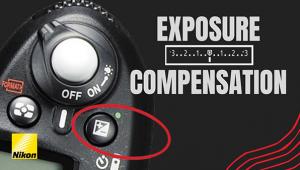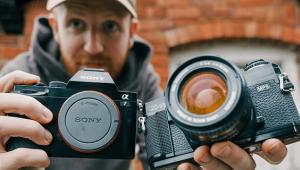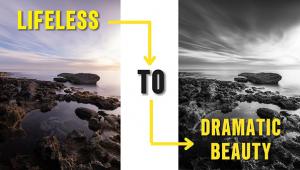The Danger Zone: Extreme Outdoor Photographer Tyler Stableford Shows Us Where the Action Is

“We’re in a two-seater F-16 over the Colorado Rockies. I’m on assignment for Denver’s 5280 Magazine, shooting a story on the pilots who are hometown heroes in the Air National Guard. And this is actually a selfie I shot with a 15mm fisheye. We were flying with a sortie of five F-16s, all choreographed so we’d be in sync. This involved G-forces up to 8 G’s and was definitely one of the most challenging shoots I’d ever done. It took everything I had.” Technical info: Canon 5D Mark II, 15mm fisheye; ISO 200, f/5.6, 1/200 second.
All Photos © Tyler Stableford
Tyler Stableford had always been passionate about storytelling, dating back to his college days. It began with the written word but soon metamorphosed into still photography. Before long, Stableford was working as an editor on two outdoor adventure publications, first Climbing Magazine, followed by Rock and Ice Magazine, where he was also able to pursue photography combined with his passion for adventure sports, which had had a hold on him since his teen years.
The year 2004 signified a departure from his full-time staff job so he could devote himself entirely to photography. A few years later the introduction of the Canon EOS 5D Mark II marked another milestone, catapulting Stableford into moviemaking. That took him and his storytelling to the next level. However, the still image would remain a staple for Stableford.
Several years later and Stableford’s forays into the moving image had paid off, with the award-winning production of a short film entitled “Shattered.” The film told the story of elite alpinist Steve House (pictured here in a still shot). The movie had an intensity and immediacy that hit you as you watched the story unfold.

“I was looking to capture the athleticism and muscularity of this climber.” Stableford accentuated climber Seth Tart’s muscularity by shooting close with a wide lens, with midday lighting. Tart was only 10 feet off the ground, involved in bouldering, where no climbing gear is used. Location: Hueco Tanks State Park, El Paso, Texas. Technical info: Canon 5D, 16-35mm f/2.8 at 24mm; ISO 100, f/4, 1/250 second.
A Risky Business
Stableford admitted that capturing adventure sports has its risks, but added that he takes steps to lessen these risks. “To be a safe adventure photographer you need to have really well developed skills in any environment where you’re working. That means being able to take care of yourself in extreme weather, being comfortable rigging your own safety lines, being well versed in self-rescue techniques and avalanche safety protocols. Most important is being a part of a team and taking good care of your teammates. I’m keeping an eye on them, and they on me.”
Asked whether he’d ever gotten caught in an avalanche, Stableford acknowledged that he hadn’t but that he’d been part of teams that triggered them. “Avalanches are relatively easy to trigger if you’re on an unstable steep snow slope. Certainly for backcountry skiing photography and such, avalanche dangers are everywhere. And just as a footnote, everyone got out okay in those avalanche situations.”
Returning to the Steve House movie, Stableford pointed out: “To make shooting this ice climb possible, I hired a professional climber to help rig the ropes for me to use in my ascent and to act as our safety steward. Compared to House’s climb, my climb was relatively easy.” This, Stableford noted, is his usual routine for climbs up boulders, rocks, and ice. He doesn’t shoot from a safe location. Stableford is there alongside his subjects, every step of the way, at least much of the time.
Part of the risk involves working far from the madding crowd. “The easy spots to get to are photographed a lot,” he said. “There’s not much chance of capturing a unique image in those spots. I’m trying to create an image that’s unique, that’s ephemeral, that’s new and compelling and dynamic, and very often that means you have to go to a remote location, not a place that exists just off the highway.”
Stableford’s years of working in the great outdoors, under trying conditions, have led to a practical philosophy about it all. He’s learned to “focus under pressure. I have a certain equanimity to perform at a high level, to allow creativity and fluidity to come in. You always have to be disciplined and on point.”

Stableford directed riders James Dixon and Magdalena Arbes for Canon Asia to promote the EOS 6D so that he’d capture sunrise flare and lots of dust in the shot. “These are highly skilled riders, and they were able to change course at a moment’s notice to avoid me, so I was not in any real danger.” Location: Castle Valley, Utah. Technical info: Canon 6D, 70-200mm f/2.8L IS II at 200mm; ISO 400, f/4, 1/1000 second.
Gear Choices
The right gear of course makes a difference for any photographer. But some of us obsess over our gear, keeping it in as pristine condition as possible. That’s not the case with Stableford.
While much of his work is handheld, you may find it hard to believe that Stableford brings a carbon-fiber tripod out into the snow and rain. Asked if he worries about the pod legs warping, he was quick to remark, “None of my gear is brand new for long. Protecting my equipment is one of the lesser concerns I have. The focus is on the shot.”
When he shoots video, Stableford also dispenses with lens hoods. The reason? He employs ND filters, often with stepper rings and larger filters that get in the way.

“This is the first time I photographed Steve House, and it was for the cover of Climbing Magazine. He’s sticking his tongue out so he could lap up some of the small spindrifts coming down on him.” Location: Maple Canyon, Utah. Technical info: Canon 5D, 16-35mm at 18mm; ISO 400, f/4, 1/80 second.
Lighting and Composition
In one respect, gear is very important for Stableford, namely that his cameras are able to shoot rapid sequences. “For a lot of action and adventure photography you’re holding the shutter down and shooting in bursts.”
But for Stableford what constitutes the defining moment in a shoot is not necessarily the moment he’s just frozen in time. Rather, it’s the lighting and composition. “The defining moment is when the light is at a unique angle, when I can shoot backlit, when I have a rich composition with the horizon at just the right position with a good balance of sky and the subject in a compelling portion of the frame.”
He added: “The point on a mountain or cliff we choose to shoot really depends on which viewpoint and rock features make the most dramatic statement. I’ll also look at the lighting—specifically noting the position of the sun to see if I can use backlighting. For instance, I’ll climb a 500-foot rock in advance so that I can study and survey it, then rappel down, to try and find the most compelling five feet of rock on that section of cliff. Once that’s established, that’s where I’ll base myself on the day of the shoot.
“The vast majority of my shots are taken at sunrise or sunset. But as a commercial shooter I need to find a way to fulfill a large shot list for a client, so that’s where I try to make the best use of the light regardless of the time of day. I talk with my clients to ascertain what the most important images are, what mood they’re trying to evoke, and schedule our most important images for the best windows of light.”

Stableford captured this athlete bike jumping through fireworks, cross-lighting with Canon Speedlites, one on each side of the frame. Location: Barcelona, Spain. Technical info: Canon 7D, 70-200mm f/4L IS at 121mm; ISO 1000, f/4, 1/400 second.
Reflecting on Flash
Given that he’s often shooting subjects that are strongly backlit prompted the question whether he uses flash, to which Stableford replied, “Yes, I use flash quite often. Where possible I prefer to use reflectors because that allows me to shoot in rapid bursts with available light.
“For shots where weight is of utmost importance, I’ll use the Canon 600EX-RT Speedlites—off-camera, I should add, using radio triggering. But when I’m doing larger shoots or where I need more power I’ll bring my Hensel Porty L 1200.” How does he manage this feat? Whether it’s a strobe or collapsible reflector, Stableford has an assistant hanging off a rope above him, gear in tow.

Stableford photographed Mark Jenkins climbing up and out of a glacier cave. “We entered the cave at the base through an opening in the glacier. I’m directly below Mark as he’s climbing, leaving me in an exposed position as chunks of ice were constantly showering down on me.” By the way, this cave has since collapsed. Location: Langjökull Glacier, Iceland. Technical info: Canon 1Ds, 15mm fisheye; ISO 200, f/4, 1/320 second.
What’s in Stableford’s Gear Bag
• Think Tank Photo Speed Racer V2.0 waist pack
• Canon EOS-1D X Mark II
• Canon WFT-E8A Wireless File Transmitter
• Canon 50mm f/1.2L USM lens (plus various others; this one gets the most use)
• Canon 11-24mm f/4L USM lens
• SanDisk 128GB Extreme PRO CFast 2.0 memory cards
• Tiffen Variable ND filter
• Canon Timer Remote Controller TC-80N3
• Canon 600EX-RT Speedlite
• Westcott Apollo 28” Speedlite Softbox
• SmallHD 702 Bright 7” field monitor
Stableford’s Favorite Gear
“One item that has been with me incessantly through the years, and through multiple new iterations of camera bodies and lenses, etc., is my favorite camera bag—the Think Tank Photo Speed Racer V2.0 waist pack. It can hold an impressive amount of gear when I strip out the center dividers; it carries well on my waist; and it has a shoulder sling so I can swing the bag to the front for easy access. Even when I’m on shoots where we have lots of large bags on set, I still have at least one or two of these Speed Racer packs to keep my shooting essentials right on my hip.”
Tyler Stableford is one of Canon’s Explorers of Light. He operates out of the Aspen, Colorado, area. To see more of his work and learn about his workshops, visit tylerstableford.com. Also, find him on Instagram: @tylerstableford. You can watch his short film Shattered at this link: https://vimeo.com/40379197.
- Log in or register to post comments







